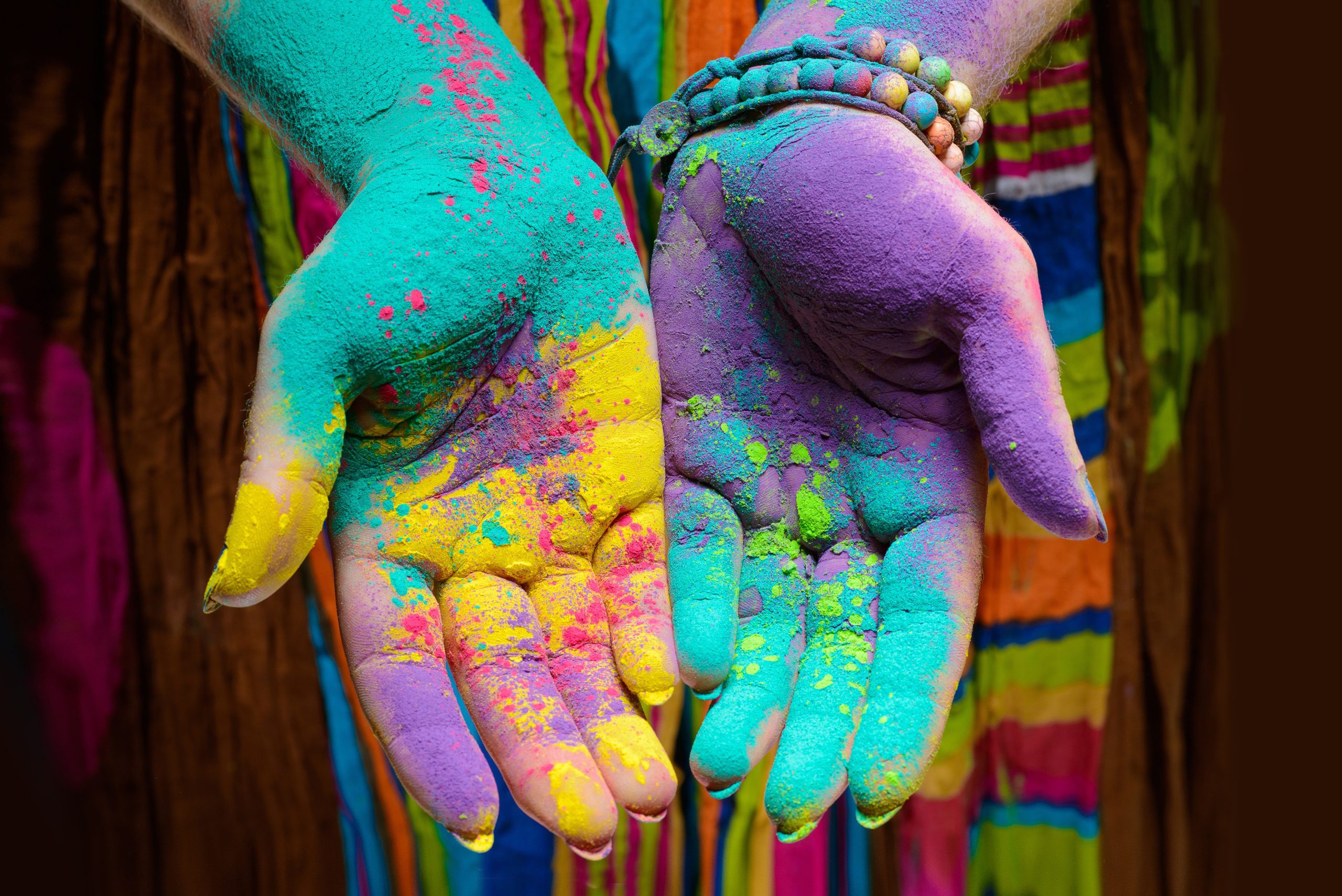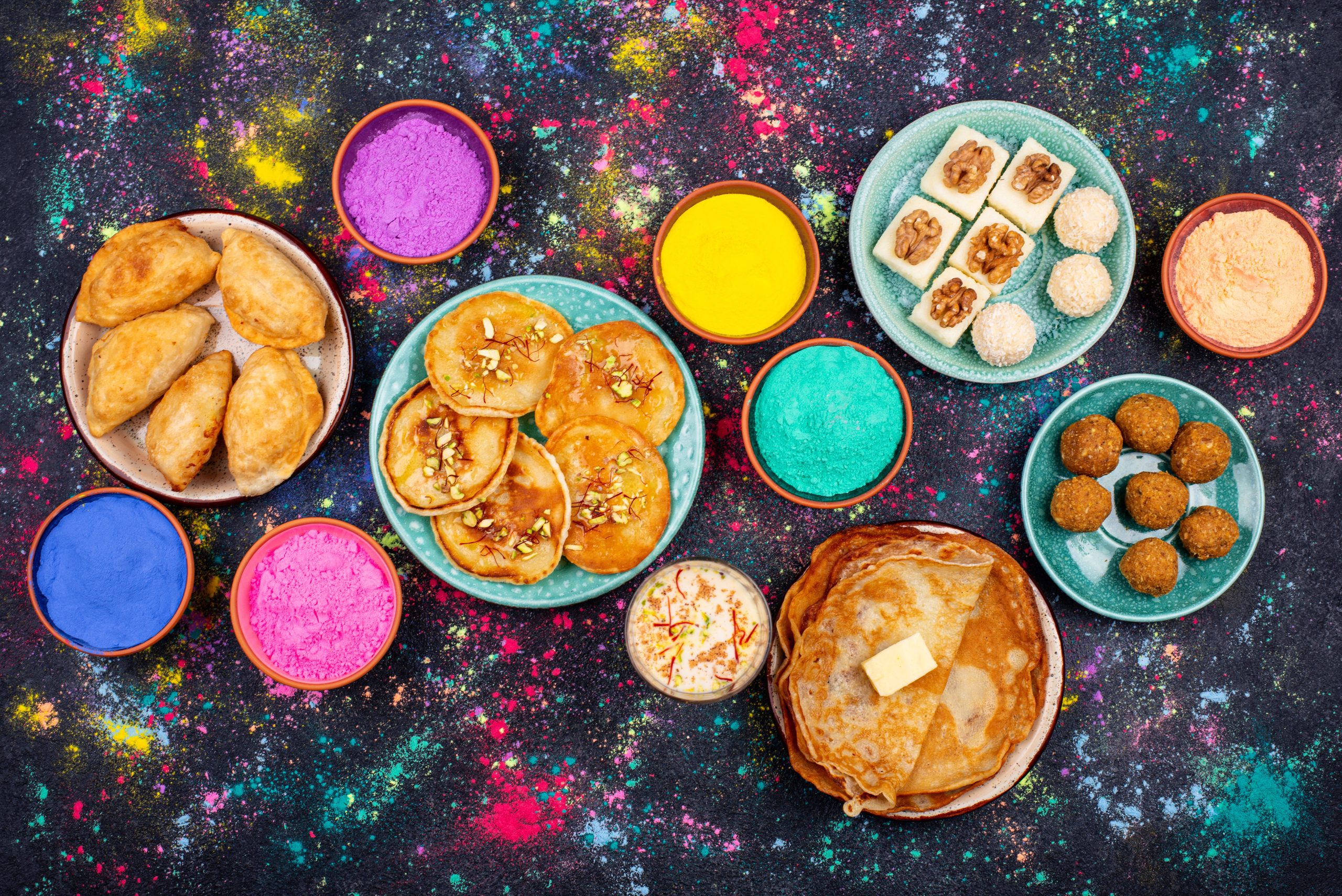If you have seen the colorful images about an Indian festival, and didn’t know what it was about . . . it’s Holi! Holi is a Hindu festival celebrated with colors to commemorate the arrival of Indian spring and the triumph of good over evil. It is also known as the “Festival of Colors.”
The festivities happen over a two-day period. On the first day, called “Holika Dahan,” a bonfire is lit in the evening. Family members and friends gather around this bonfire and throw wheat sheaves, coconut, and green chickpeas into the flames as a token of gratitude for the spring harvest. They pray all their negativities are burned in this bonfire to bring positivity in the coming year.
The second day is the actual fun celebration. Powdered colors are playfully dabbed on each other and color-filled water balloons are thrown. It is known as “Rang Panchami” or “Dhulivandan.” Unlike other Indian festivals, old or worn-out clothes are worn on this day as color and water play are encouraged.
As someone from India, I have fond memories of this festival. I used to start my day by smothering gulaal (powdered color) on my unsuspecting brother and then running away to avoid getting dabbed in those colors. It never worked, but it was fun to play these pranks.
Read more to learn about this colorful festival, and how the festivities are conducted!
*words in bold can be found at the bottom of the post in the glossary!
Why is Holi celebrated?
Hindu mythology signifies Holi as a celebration of good over evil and it is believed to be about the story of Prahalad and Hiranya Kashyap. As the story goes:
Once upon a time there lived a demon King named Hiranya Kashyap, who was granted a wish to be immortal. He could not be killed by a human being or an animal, neither indoors nor outdoors, neither at day nor at night, not by any manmade weapon, and neither on land nor in water or air. He became arrogant with such powers and wanted everyone to only worship him like God. His son, Prahalad, who was a devotee of Lord Vishnu, did not agree with this, and that made the King furious. He grew very abusive towards his son and constantly gave cruel punishments; however, it never affected Prahalad or changed his mind to worship his father instead.
One day, the King and his sister, Holika, plotted Prahalad’s death by tricking him into sitting on a pyre with her. She would wear a cloak which was immune to fire, while Prahalad would not. As the fire roared, the cloak flew away from Holika and engulfed Prahalad, protecting him, while Holika was burned down.
To end the evil regime of the King Hiranya Kashyap, Lord Vishnu–the Hindu god–took the form of Narasimha who is half human and half lion (which is neither a human nor an animal), at dusk (when it was neither day nor night), took Hiranya Kashyap at a doorstep (which was neither indoors nor outdoors), placed him on his lap (which was neither land, water, nor air), and then killed the king with his lion claws (which were not any manmade weapon).
And thus, Holika Dahan (the bonfire) and Holi signifies the celebration of the symbolic victory of good over evil, of Prahalad over Hiranya Kashyap, and of the fire that burned Holika.
Another story tells about the playful prank played by Lord Krishna on his beloved Radha. Lord Krishna was dark skinned and as a child, was very jealous of Radha’s fair complexion. One day, he complained to his mother about this injustice of nature of how Radha was so fair and him being so dark. To pacify him, Yashoda, his mother, told him to apply any color of his choice on Radha. Mischievous Krishna found a powdered color and dabbed it on unsuspecting Radha, making her like himself.
This beautiful scene of Krishna’s prank, in which he played color with Radha and other gopis (milkmaids), has been shown in myriad forms in several paintings and murals and is the reason for current Holi celebrations.
What kind of food is eaten during Holi?
Since I come from Mumbai, which is in the western part of India, my family makes puranpoli, which is a type of sweet bread made of crushed lentils and jaggery, along with spicy rassa curry and onion pakoras (fried onions). I have tried making puranpolis like my mom, but it is never the same, and I miss it dearly!
In northern India, mathris (crisp-fried savory biscuits), malpua (fried pancakes), and sweets like gujiyas and jalebis are made ahead of time for Holi celebrations. Cold beverages thandai and bhang are Holi specialties and made with or without alcohol.
How do you play Holi?
First, you will need to wear worn-out clothes or clothes you don’t mind messing up–a lot of colors and water will be sprayed during the celebration! To play Holi, you will need powdered colors which you can either buy from the store, or make at home. Here is a simple step-by-step guide for making them at home:
- Mix flour and water in a large bowl until it forms into a thick paste.
- Separate the flour paste into different bowls to make different colors.
- Add your favorite food coloring to each paste and mix it in with your hands. (You may want to wear a pair of disposable gloves, so the food coloring doesn’t stain your hands!)
- Scoop the paste from the bowl and form it into a ball with your hands.
- Use a rolling pin to flatten the ball into a disk that is about 1/4 inch thick.
- Let the disk sit overnight until it is completely dry.
- Use a grinder/mixer to crumble the disk back into powder. (Adults should do this or help with this step.)
- Store the powder in a bag for future use.
This is also a great time to involve kids in making the colors and have a nice family activity. Another fun activity with kids is to make colored water balloons. Add different food coloring to the water, and use a balloon pump to blow the balloons up!
What should we be mindful of while playing Holi?
While Holi is meant to be playful, it can sometimes go sour if someone is not willing to play. This is a good time to teach children about consent and boundaries. Here are some of the things that you can try with your child to explain how Holi needs to be played:
- Always check with the person you are playing Holi with to see if they are fine with putting color on their face and body, or are ready to play with water. They should not be considered a poor sport because of their choice, and should always be respected.
- While the festival is played by kids and adults, boundaries should be set up for what is acceptable play, especially if someone is not comfortable and/or has a reaction to certain products.
- Set timelines for when Holi will be played so that unsuspecting people will not fall to the prank, creating problems during the festival.
- Explain to your child or friends about area boundaries, like where they can play–for example, only in the backyard or open areas or certain areas of the home, to avoid messing up the property during play.
- Tell your child to play colors only with their friends and family, and not with pets. The powdered color settles on their fur, is not easily removable, and can cause irritation.
Learning Resources for Kids
Kids can have a lot of fun during Holi, as it is supposed to be messy play! However, this time can be used to teach them about the festival as well. Here are some books and resources, specifically designed for kids:
- Festival of Colors by Kabir Sehgal and Surishtha Sehgal
- It’s That Time of Year! Holi is Here! by Vanessa Kapadia
- Non-toxic Holi colors and Holi activity kits from Kulture Khazana
- Pichkari from Desi Favors (a color dispenser to play on Holi)
- Local Hindu temples in Detroit have Holika Dahan bonfires and Holi festival celebrations planned. It’s a great time for kids to experience and play Holi in the community.
Glossary
Bhang: An edible preparation made from the leaves of the cannabis plant originating from the Indian subcontinent.
Gulaal: The name given to the colored powders (usually pink in color) used to play the Holi festival.
Pichkari: A water gun or cannon.
Thandai: An Indian cold drink prepared with a mixture of almonds, fennel seeds, watermelon kernels, rose petals, pepper, poppy seeds, cardamom, saffron, milk, and sugar for Holi.
I hope you learned a little bit about my culture, and will celebrate Holi with me! Wishing you a very Happy Holi from all of us at Detroit Mom!













